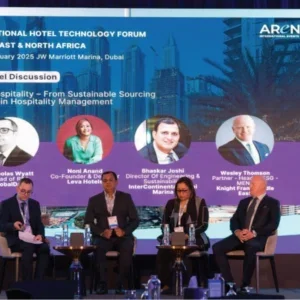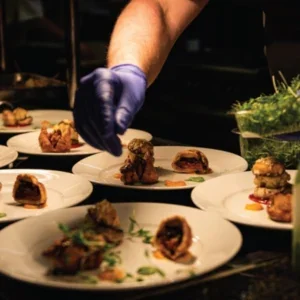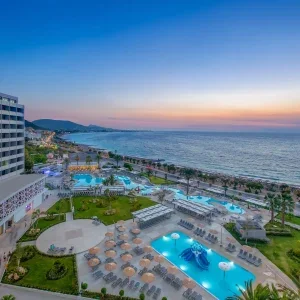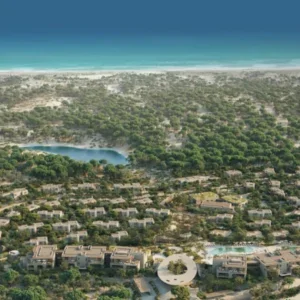It was all looking so good. Diversification was beginning to reduce the total dependency on oil; Expo 2020, the massive world fair with 138 nations participating, was being prepared in Dubai, UAE, with huge infrastructure projects, of hotels, transport links and exhibition buildings, to feed it. Qatar was hosting the World Cup in 2022. Both of these would bring in huge numbers of visitors to kick-start a resurgence of tourism. And the price of oil on which it all depended was up around $68 a barrel at the start of the year which is near where Middle East governments, the Saudi government in particular, want it or need it before they begin to make serious money that can be spent on projects such as these. It was true that the days when money was no object were past; but investment was happening, opportunity was there, and with it there was optimism. Then the pandemic struck.
No-one flew anywhere, no-one travelled anywhere, no-one needed to fill up their cars or their planes or their machinery with fossil fuel. Construction projects around the world were put on pause; and the demand, and so the price, of oil went down and went down and went down. A Russia-Saudi over-production war at just that moment did not help. By March oil touched a low of $22/bbl. Hardly surprising, then that orders for lifting equipment in the area went down with it.
“The prospect for market at start of 2020 was very bright,” says Vikas Jaswal, sales manager for Alwaha Cranes, Dubai, official distributors for Street Crane in the region.
“There were many upcoming projects for which tenders had been floated and earlier announced projects for which finalisation was due at the start of year 2020.
“Many government initiatives were started to support economic activities in infrastructure projects: renewable energy, power plants, water desalination and sewage treatment plants (STP). But due to the present scenario some of these projects were put on hold and some were moved to next year.”
Suhan Shetty, Street Cranes’s regional account manager for the Middle East, puts it succinctly: “We were seeing lending; then there was Covid.”
Osama Khan, technical manager of the ACE cranes group, based in the UAE, tells the same story: “The Middle East is not doing totally well at present. Oil is down; the coronavirus is having its effect. The market is not very buoyant in industrial sectors, especially in the GCC region [of Bahrain, Kuwait, Oman, Qatar, Saudi Arabia and UAE].” There are one or two brighter spots, though: “Saudi Arabia is altogether different. Saudi is doing not too badly—not as well as it was pre-Covid, but still better than the rest of the region.”
BLACK GOLD
Khan of ACE: “Oil of course is what everything depends on. It uses hoists directly, or in trickle-down to many other industries that supply oil and gas or are dependent upon it. There is construction, and some tourism, but they all boil down to oil at the end of the day. Saudi Arabia generates projects for the whole region, and Saudi depends on oil.
“And there are some very big projects, especially in Saudi Arabia. Aramco has a very nice multi-billion-dollar maritime industries project at Ras Al-Khair, and there is SPARK, the King Salman Energy Park, which is also coaxing up many other projects. Those are oil- and gas-related. There are power plants; there is refining in Qatar; Bahrain has expanded its aluminium plant; and there are military projects also.”
Young of Konecranes agrees that there are still projects around: “While it’s true that the lower price of oil slowed down the pace of investment in 2019, there has still been activity seen in publicly announced projects such as Saudi Aramco’s $18 billion contracts to increase Marjan and Berri oilfields’ production capacity and ADNOC’s $3.5 billion upgrading of the Ruwais refinery, which was announced this year. And we would note other areas including construction, infrastructure—including power and desalination plants—logistics and steel. Konecranes’s lifting equipment can be found in all the region’s main ports, for example.”
And downturns give opportunities for those who do not need quick returns: “Although some of last year’s announced projects are cancelled or postponed, some of big oil corporates are more interested in investment and are considering this as a perfect moment for long term,” says Jaswal of Alwaha. “And there is more push on modernisation or refurbishment activities as this can be done cheaply without hampering productivity and at shorter lead times.”
Kuhnezug sells throughout the region. Sales director Vishnu Upadhyay says that his company has been benefitting from the diversification. “For us so far we do not have a massive direct link to oil. We make production cranes and explosionproof cranes, but generally we supply to the support industries rather than to the oil extraction industries themselves. We supply all over the Middle East; we have a power project in Ethiopia, we are working in Egypt, and Libya as well as Saudi Arabia and Jordan and the emirates. There is a delay in some of the projects we are involved with, but so far no cancellations.”
Rohan Warty, CEO of Electromech, agrees: “Investment in oil still remains the main market for lifting equipment but we have seen a steady increase in projects in heavy engineering, renewable energy and infrastructure. In fact we are executing a large order for a shipyard in Saudi Arabia to supply approximately 170 cranes. This is going to be the largest shipyard in the region and is in line with the Vision 2030 set by Saudi crown prince HH Mohammed Bin Salman. There are other projects in the precast and infrastructure sectors, and a few projects in the renewable energy which will also help the lifting industry.”
“90% of business used to be oil and gas,” says Peter Zaremba, international sales manager for Latin America and the Middle East at SWF Krantechnik. “Now governments are diversifying and investing, and encouraging investment in different segments; so we have been getting enquiries from new sectors such as renewables and infrastructure projects. In Saudi, the Riyadh Metro is nearing completion. Of course there are still the financial problems of last year. The region is trying to diversify but it is still dependent on oil and gas.”
CONTACTLESS PAYMENTS
A major handicap is the current difficulty of actually meeting with customers to close a deal.
“I’ve not been able to visit since early February because of Covid,” says Suhan Shetty of Street Crane. “Flights are cancelled and business meetings are no more. Of course video conferences happen, but meetings in person face-to-face have much more impact and are so much better for all. So a lot of projects are on hold, because there is no travel for face-to-face finalisations, and because people are waiting for the market to stabilise: they are being cautious, and most understandably.”
Even so, he says, interest has not died. “During lockdown, orders never stopped and deliveries went on as normal. Obviously we observed social distancing in our factory, and had very limited number of people at the site, but we managed, and we have delivered some good orders, though all were based on pre-Covid discussions.” There is, though, another problem: “Cash flow has stopped,” he says. “People are cautious. They want more time to pay because they themselves are not getting paid.”
Peter Zaremba at SWF Krantechnik finds the same phenomenon and points to new business methods that the change has brought. “Things have changed since last year,” he says. “Sentiment is the same or better. What has changed is the business model that customers pursue.” That change has been caused by a shortage of cash. “There is a big cash flow problem. The days of freewheeling cash supply are long over. Payments conditions now range from three months to one year.”
Partners and dealers, he says, have therefore had to change their strategies. “Our partners used to sell to the end customer, often the government or one of the ministries, say of water or of power. Now they deal with the main contractors, who become intermediaries and who take on the financial risks. Our dealers used to accept the risks themselves. Now they pass them on; that is something new.
“There are still a lot of projects in the whole region,” he says. “The only thing holding them back is the question: ‘who is willing to take the financial risk?’ Everyone wants to do things: no one has the money to pay for them.
“Project owners often want to put the risk on to us, but that is not our business: we are crane-builders, not a bank or a financial institution. “For example, in Qatar we have a huge partnership with a company that is connected with a member of the Royal Family. That company is willing to take on financial risk; whether it is over six months or over 12 months they will get their money in the end and they have pockets deep enough to wait until they do. So that partnership is a very good one for us.
“But a lot of small crane dealerships have gone out of business because they do not have that resource. I would say that 90% have disappeared. The only survivors are huge groups which belong to the royal families, with interests in many sectors of which cranes and lifting are only one. “In Saudi Arabia it is the same. Even our partner there has been affected. Until six months ago they were taking on risk themselves; then they said ‘we want to be on the safe side: we will work only with the main contractors.’ That way they are sure to get paid.”
Different countries have different conditions. “In Oman we have two partners and we push hard; but it is a very limited market” says Zaremba. “However there is a policy of ‘Omanisation’: costs are lower in UAE than in Oman, which means that in the past clients bought from UAE. But now local companies and suppliers have to source locally, from Oman. That actually helps us because our partners are Omani.”
“All the major economies in the region have a long-term vision to diversify from oil.” says Warty, “hence investments in the no-oil sectors are bound to grow in the years to come. A few challenges like access to local talent do make it difficult for companies to invest in the region but again in the long term the vision of the local leaders is to have an eco-system where the local talent has the necessary education. Electromech is extremely bullish about the long-term prospects about the region and is on track to have one of its best year so far in the region.”
Street Crane’s Shetty confirms the troubles of small companies, and says they are not confined to the lifting sector: “Some little companies might not come back after Covid. Many orders for off-the-shelf lifting gear come from small companies; if that dries up it will be worrying.”
CHANGING DEMANDS
Last year we reported that European-made cranes still had the advantage in demand over cheaper Chinese imports. Shetty now reports a curious twist to that. “In the past buyers didn’t care about price; they just specified European product and quality. People were aware of our UK quality and put a premium on it. And more than once we have heard ‘Oh we don’t want Chinesemade on our project.’
“But more and more, in UAE and even in Saudi Arabia, Chinese companies are investing in EPC projects, and then they take care of the supply chain for the whole project and of course specify Chinese; we lost one project because of that.
“But Street Cranes have a distributor in China as well as our usual Middle East distributors. Out of the blue on one project our Chinese distributor became involved; which showed us that the investor was a Chinese one. It helps us, but it is very hard to match Chinese prices.”
But even the downturn has a silver lining: “The spare parts business is considerably up,” says Shetty. “Usually people have to slow down production to service their cranes. But if their factory is at less-than-full capacity anyway they are taking advantage of that to service their cranes. So we are doing much better than last year on spares. But of course new hoists and cranes are what we want.”
And, lest this piece gives too dark an outlook: “We are actually busier than last year, when business was low,” he says. “It is now not as high as we expected, because of Covid, but still it is up on last year. And levels of enquiry have never stopped. They are often about feasibility studies, we do not see them yet in the final stages, but post-Covid they may mature. So looking deeper, these could be for the longer-term; but still, they are there.”
Upadhyay of Kuhnezug is another who sees no cause for despair. He takes a philosophical view: “Power is our key: we supply the power to lift, and lifting ability is a must for any industry. You cannot stop industrialisation. It will go on moving ahead, regardless of short-term traumas; people need the products of industry to grow, and populations are increasing and will need more of them. Infrastructure is in the end vital, whatever the price of oil is doing. “Oil proceeds of course fell dramatically with Covid as demand for oil plummeted; but as soon as the price goes up, so will government spending. $60 or $70 a barrel will see things starting to move again. Governments then will have projects, and the projects will need cranes.
“So there are desalination plants, which are complex and congested sites and which need specialised lifting. At present we are supplying a big sugar refinery in Egypt with very large gantry cranes; they are 45t capacity, 70m span, and stand 50m high; from the top you can see the countryside for miles around. As a company we specialise in the unusual; we engineer beyond the specification. We are German manufacturers, and that helps. People know that we are not compromising on any of the features of our cranes. People are keen to survive. We will wait for better times; and they will come.”
“With the push for local content both in Saudi Arabia and UAE there is genuine interest among many manufacturers to set up base in the GCC,” says Warty. Zaremba of SWF sums it up: “In the very long term we see a lot of investment in different sectors. It all depends on oil. It will be five to 20 years before the region is walking on its own legs without the crutch of oil.
“Still, in the short-term things are a little better than a few months ago. Back then, oil was at $20 a barrel; at time of writing (end of August 2020) it is in the mid-40s. But it is still a long way from the $70-odd that governments there need before they are making really serious money that they can invest in large projects.”
“We have to wait until the end of the pandemic,” says Shetty. “We don’t know how much more of it is to come.” “I am optimistic,” says Khan of ACE group. “We have no choice, we have to be! People will come back; it doesn’t happen that when economies tank then everything closes. Companies that can get through will do alright afterwards. The ones who cannot handle the hard times will go under but others will come along and fill the gaps. As ever, if you can control your expenses and produce in a leaner manner, you stand a good chance.”






